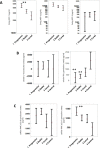Echinococcus multilocularis specific antibody, systemic cytokine, and chemokine levels, as well as antigen-specific cellular responses in patients with progressive, stable, and cured alveolar echinococcosis: A 10-year follow-up
- PMID: 35108275
- PMCID: PMC8809567
- DOI: 10.1371/journal.pntd.0010099
Echinococcus multilocularis specific antibody, systemic cytokine, and chemokine levels, as well as antigen-specific cellular responses in patients with progressive, stable, and cured alveolar echinococcosis: A 10-year follow-up
Abstract
Background: The infestation with Echinococcus multilocularis larvae may persist in humans for up to decades without evident clinical symptoms. Longitudinal investigations are needed to understand the dynamic immunological processes in alveolar echinococcosis (AE) patients associated with an active and progressive, a stable or a regressive course of disease.
Methodology/principal findings: This study evaluated the E. multilocularis specific antibody responses, systemic cytokine, and chemokine serum levels over a 10-year follow-up period, as well as cellular responsiveness in AE patients. Our results demonstrate a rapid decrease in antibodies against E. multilocularis specific antigen Em2+. Especially in cured patients, these antibodies remained negative, making them a significant predictor for cured AE. E. multilocularis specific IgG4, and indirect hemagglutination IHA decreased later in time, after around 5 years. While total IgE did not show significant dynamics over the course of disease, E. multilocularis specific IgE decreased after one to two years, and increasing levels were a significant predictor of progressive disease. There was no significant change in systemic IL-8, IL-9, CCL18 or CCL20 serum levels over time. Univariate analysis across groups indicated lower IL-8 levels in cured patients; however, this result could not be confirmed by multivariate analysis. Levels of CCL17 decreased during treatment, especially in cured patients, and thus might serve as a predictive or risk factor for progressive disease. Levels of IL-10 and CCL13 decreased during disease, especially after five and ten years of intervention. The E. multilocularis antigen (EmAg) inducible cellular productions of MCP1(CCL13), TARC(CCL17) and PARC(CCL18) were lowest in patients with cured AE and infection-free controls, while the EmAg inducible cellular production of IFN-γ increased after cure. Significant positive cytokine and chemokine correlations were observed in AE patients for IL-9, IL-10, CCL13(MCP-4), CCL17(TARC) and CCL20(LARC)(for all p<0.001). E. multilocularis specific IgG4 response correlated positively with TARC (p<0.001). Both markers enhanced over time in progressive disease and decreased after cure. The levels of IL-8, IL-10, MCP4 and LARC enhanced with AE regression.
Conclusions/significance: Repeated biomarker surveys are advisable to evaluate progression or regression of disease during longitudinal follow-up and such analyses can support imaging techniques and improve staging of AE patients.
Conflict of interest statement
The authors have declared that no competing interests exist.
Figures


Similar articles
-
Distinctive cytokine, chemokine, and antibody responses in Echinococcus multilocularis-infected patients with cured, stable, or progressive disease.Med Microbiol Immunol. 2014 Jun;203(3):185-93. doi: 10.1007/s00430-014-0331-8. Epub 2014 Feb 9. Med Microbiol Immunol. 2014. PMID: 24509604
-
Echinococcus multilocularis: inflammatory and regulatory chemokine responses in patients with progressive, stable and cured alveolar echinococcosis.Exp Parasitol. 2008 Aug;119(4):467-474. doi: 10.1016/j.exppara.2008.04.006. Epub 2008 Apr 14. Exp Parasitol. 2008. PMID: 18490012
-
Echinococcus multilocularis metacestodes modulate cellular cytokine and chemokine release by peripheral blood mononuclear cells in alveolar echinococcosis patients.Clin Exp Immunol. 2006 Aug;145(2):243-51. doi: 10.1111/j.1365-2249.2006.03142.x. Clin Exp Immunol. 2006. PMID: 16879243 Free PMC article.
-
Molecular survival strategies of Echinococcus multilocularis in the murine host.Parasitol Int. 2006;55 Suppl:S45-9. doi: 10.1016/j.parint.2005.11.006. Epub 2005 Dec 13. Parasitol Int. 2006. PMID: 16352460 Review.
-
Survival strategy of Echinococcus multilocularis in the human host.Parasitol Int. 2006;55 Suppl:S51-5. doi: 10.1016/j.parint.2005.11.007. Epub 2005 Dec 19. Parasitol Int. 2006. PMID: 16360335 Review.
Cited by
-
The expression of CTLA-4 in hepatic alveolar echinococcosis patients and blocking CTLA-4 to reverse T cell exhaustion in Echinococcus multilocularis-infected mice.Front Immunol. 2024 Mar 28;15:1358361. doi: 10.3389/fimmu.2024.1358361. eCollection 2024. Front Immunol. 2024. PMID: 38605966 Free PMC article.
-
Human Dialyzable Leukocyte Extract Enhances Albendazole Efficacy and Promotes Th1/Th2-Biased Lymphocyte and Antibody Responses in Peritoneal Cavity of Murine Model of Mesocestoides vogae Infection.Int J Mol Sci. 2025 Jul 21;26(14):6994. doi: 10.3390/ijms26146994. Int J Mol Sci. 2025. PMID: 40725240 Free PMC article.
-
Induced hepatocyte-like cells derived from adipose-derived stem cells alleviates liver injury in mice infected with Echinococcus Multilocularis.Sci Rep. 2024 Nov 1;14(1):26296. doi: 10.1038/s41598-024-77555-8. Sci Rep. 2024. PMID: 39487286 Free PMC article.
-
[Treatment concepts for hepatic echinococcosis].Chirurgie (Heidelb). 2023 Jun;94(6):560-570. doi: 10.1007/s00104-023-01825-w. Chirurgie (Heidelb). 2023. PMID: 36853342 German.
-
18FDG-PET/CT-Scans and Biomarker Levels Predicting Clinical Outcome in Patients with Alveolar Echinococcosis-A Single-Center Cohort Study with 179 Patients.Pathogens. 2023 Aug 14;12(8):1041. doi: 10.3390/pathogens12081041. Pathogens. 2023. PMID: 37624001 Free PMC article.
References
MeSH terms
Substances
LinkOut - more resources
Full Text Sources
Miscellaneous

